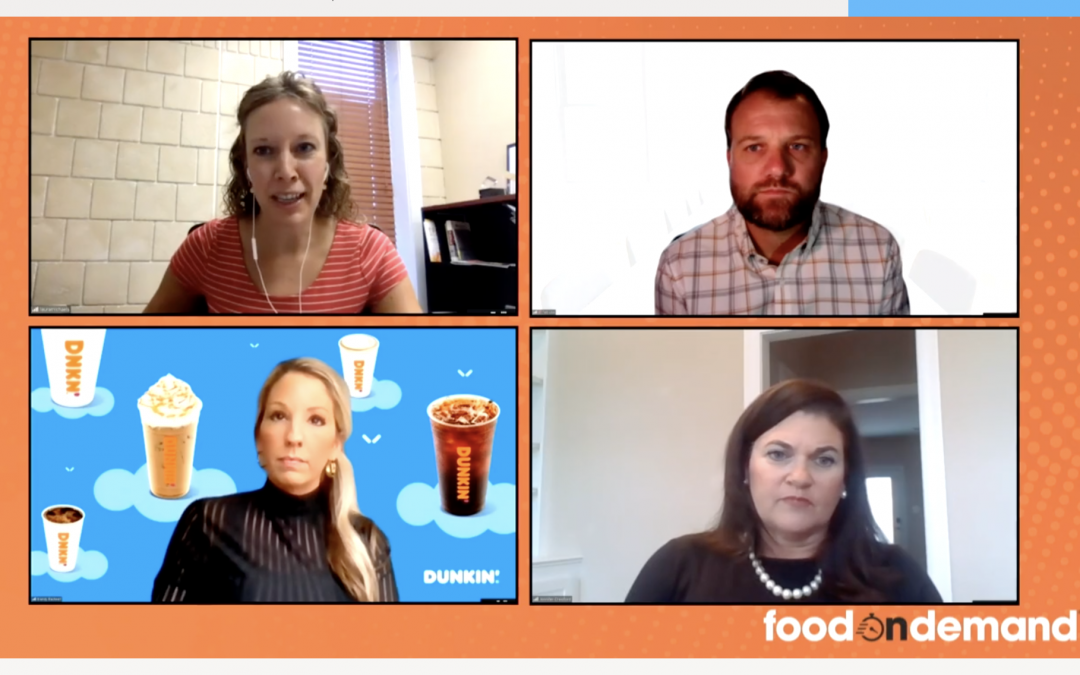The last couple of months have been “crazy” for Moe’s Southwestern Grill while many of the pending projects the franchise had in the works were rolled out quickly to meet the demands caused by the pandemic, such as a free delivery campaign at 550 stores, Tad Low, senior director of marketing, field and off-premises, for Moe’s, told the audience for the Franchise Delivery Ops panel on Day 2 of FODC.
The panel, moderated by Franchise Times Editor-in-Chief Laura Michaels, also included Brandy Blackwell, director of delivery and catering for Dunkin’ Brands, and Jennifer Crawford, Fazoli’s director of off-premises and field marketing.
The free delivery was for the first six weeks, and the fast-casual chain also launched a curbside pickup service which sold meal kits and individual meals. “We took what we were doing for larger groups and scaled it down for four to six,” Low said about their catering operation. In just a matter of days, Moe’s rolled out a grocery market feature to supply protein to guests after a franchisee pointed out that traditional grocery stores were running out of meat.
About 90 percent of franchisees in the system are on third-party delivery through Olo Dispatch.
Fazoli’s, a QSR featuring pizza and pasta, “leaned on our drive-thrus, which were already strong,” Crawford said. They already had takeout in place with four third-party delivery providers, so they were able to focus on marketing those two options as a replacement for in-store dining, and getting catering items on the delivery menu. A popular destination for after-church Sunday dinners, Fazoli’s quickly pivoted to offering a family meal deal guests could take home in lieu of dining in.
And since one of the popular features of a meal at Fazoli’s is the warm breadsticks employees walk through the dining from and hand out, employees went outside to pass out breadsticks to drivers stuck in long lines in the drive-thru.
Sales started to rebound in May, she said, and franchisees are now up more than 5 percent.
To date about 95 percent of the system is on third-party delivery platforms, and 75 percent on ezCater. The average check for delivery is $22 versus $14 for dine-in, Crawford said. Delivery accounted for 10 to 12 percent of sales pre-COVID, she said, but they’re seeing double that with dining rooms closed.
Delivery sales also doubled at Dunkin’ during the pandemic, Blackwell said, and the average check total is 2.5 percent higher than in-store sales. “One thing with Dunkin’, we go up and beyond with rollouts,” she said. “There’s a lot of handholding—in a good way.” When they sign up with a third-party delivery provider, she explained, the franchisor enrolls franchisees in a data pool so they can monitor it. They also train franchisees on the third-party’s system, creating their own readiness guide on best practices.
Dunkin’ is taking a look at packaging choices and how packaging can be one tool in keeping refunds down for incorrect orders or improperly delivered food.
Moe’s Low pointed out that the delivery customer is different from the in-store dining customer. Stores that turned on delivery in their trial period found it was creating another sales avenue, not taking away from existing sales. They are also testing their own delivery service “and that’s been promising,” he added.
The addition of high-volume delivery, Low said, makes the host’s job a lot more complicated—not to mention the kitchen. “We’re looking at a second make line,” he said.
In closing Michaels asked the $64,000 questions: Are franchisees happy with third-party delivery?
“We have a mix of happy and unhappy franchisee with it,” Crawford admitted. “Some don’t like the fact that they’re not in control of the guest experience.” And while conventional wisdom is that early adopters are usually happier with change than late adopters: “Some of your late adopters can be your brand champions because they’ve watched the process and how it’s working.”
Low said third-party sales are still a concern for profitability since royalties are paid on those higher prices.
But right now no one’s going to argue that delivery isn’t a viable revenue stream.




